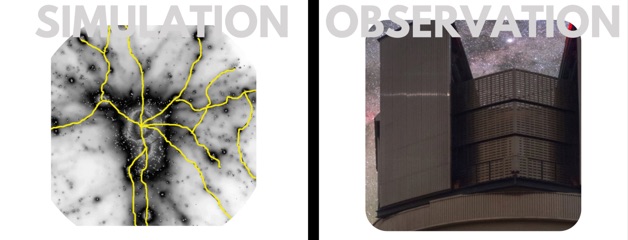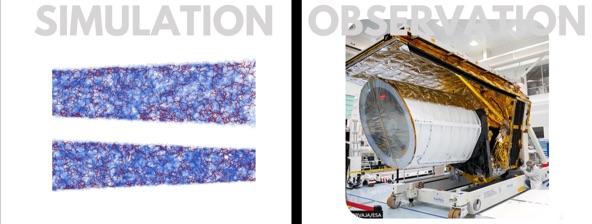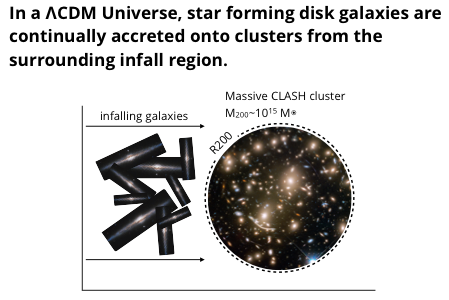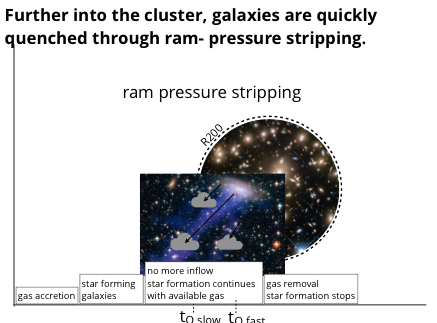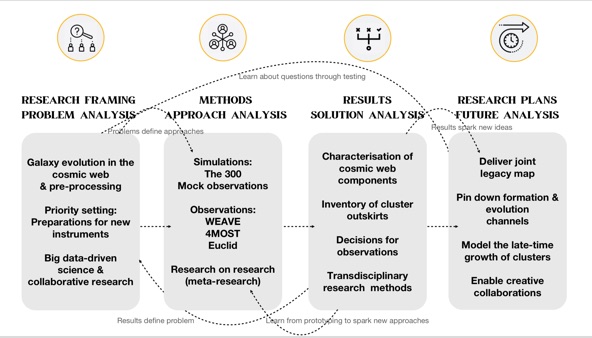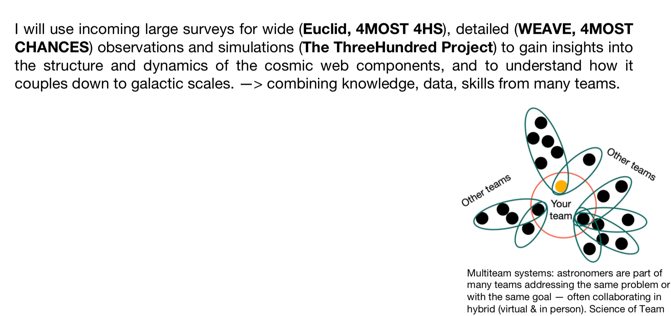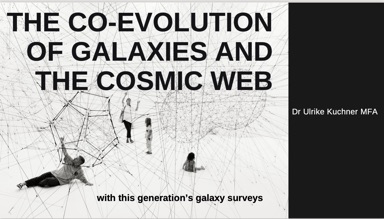Astronomy

A call for detailed galaxy morphologies
Although our theoretical framework makes robust predictions for the mass functions of dark matter halos, it is so far not able to fully reproduce the observed visible properties of galaxies. The fundamental challenge is to measure observationally the stellar mass-assembly history of galaxies at various cosmic epochs to constrain models of galaxy formation and evolution. However to date most of the scaling relations and detailed statistical comparison between observations and simulations have been done for the global galaxy population, with little explicit attention to groups and clusters of galaxies, and also treating galaxies as whole entities as opposed to considering galaxy bulges and disks separately. The recent expansion of very high quality photometric and spectroscopic observations, of increasingly large statistical samples of galaxies now enables detailed studies of the stellar mass assembly of resolved galaxy bulges and disks as a function of local environment, look-back time and spectral properties. In my research, I investigate the dependence of the physical properties of galaxies and their bulge/disk components in a wide range of galaxy environments and halo masses. Specifically, I explore the following questions:
-
1 What changes the structures of galaxies over cosmic time? Are these internal or external processes? What are the roles of galaxy clusters, (infalling) groups and filaments in driving galaxy evolution?
-
2 Which factors trigger or stop (quench) galaxy-scale star-formation? What regulates star-forming galaxies through cosmic time and does the bimodality arise from the timing and physics of cosmological structure formation or from baryonic physics?
-
3 How do bulges and disks form and grow? Are they really distinct components? What role does AGN feedback play in limiting central star formation and the formation of a massive bulge?
The Euclid morphology challenge
Euclid Collaboration: Bretonniere H., Kuchner U., Huertas-Company M., Merlin E. et al, “Euclid preparation. XXVI. The Euclid Morphology Challenge: Towards structural parameters for billions of galaxies”. A&A, 2023, 671, A102, 29.
This is the second of two key pre-launch deliverables from the Euclid Morphology Working Group and presents the reference for high-quality galaxy morphology measurements for billions of galaxies imaged with Euclid. It is the culmination of a five-year and highly complex “Morphology Challenge” that grew from initial exploratory studies that I led and that I subsequently advocated for. The first author is a PhD student for whom I was the de facto co-supervisor for this part of his PhD. He won a Euclid star prize for this work in 2023. In this paper, we evaluated and assessed the accuracy of the parametric galaxy morphology measurements from five state-of-the-art surface-brightness-fitting codes applied to galaxies of varying complexity simulated for the Euclid Wide Survey. Results of this Challenge led to the selection of fitting code now implemented in the Euclid pipeline.
Past research
Do the relations between stellar mass and gas metallicity as well as stellar mass and size hold in clusters? Do the physics of metal enrichment evolve with cosmic time?
My approach to answering these questions was observationally driven and enabled by the development and implementation of relevant – photometric and kinematic – parameter measurement algorithms that increasingly link photometric decompositions and spectral diagnostics of galaxies. The use of machine learning and supercomputers built pathways towards big data galaxy surveys.
In my research conducted during my Ph.D. as part of the CLASH Survey (Cluster Lensing and Supernova Survey with Hubble; Postman et al., 2012), I focused on the observational analysis of properties of galaxies in clusters at intermediate redshifts. I have made extensive use of multi-wavelength observations of individual galaxies and galaxy clusters from ground- and space-based telescopes, as well as VLT-VIMOS multi-object spectroscopy and integral-field spectroscopy – including the data reduction, measurements and analysis.
In Kuchner et al., 2017, (2017A&A...604A..54K) I investigated the influence of a massive cluster on the size distribution of spectroscopically confirmed members of cluster galaxies. I used the galaxy mass-size relation to improve our understanding of how galaxies change their properties in dense environments. I have been able to show that the manifestation of the size distribution of galaxies in clusters is due to an outer disk-fading and possible bulge growth that accompanies the varying fraction of star-forming and quiescent galaxies.
In Maier, Kuchner et al., 2016, (2016A&A...590A.108M) I tested the connection between the chemical enrichment in cluster galaxies and their morphologies. We investigated environmental dependencies on the stellar mass – metallicity and stellar mass – star formation rate relations and found that any (subtle) differences of the distributions of cluster and field galaxies can be traced back to the strength of their bulges. We showed that evolutionary paths of model galaxies need the implementation of strangulation scenarios to explain the higher gas-phase metallicities of accreted cluster galaxies.
Galaxy Evolution Background: Galaxy Morphologies & Cluster Environments
It is still unknown and rarely discussed whether the disk evolution is directly affected by bulges and how the galaxies settled with time. Some suggest that the main driver for gas depletion in galaxies is the bulge mass (Saintonge et al., 2012) and that the bulge is the dominant factor for star formation rates and quenching (Abramson et al., 2014, Morselli et al., 2017). To gain meaningful insight into the star formation history of a galaxy, we need to consider that galaxies interact with their surroundings through feedback processes such as galactic inflows (gas accretion) and outflows (winds) (Dalcanton, 2007). This makes disk re-growth possible and changes a galaxy’s chemical evolution and, subsequently, metallicity and gas fraction. However, in dense environments, gas flows are disrupted and re-growth should be much less effcient.
Massive local galaxy clusters are the product of a combination of smooth accretion and ingestion of smaller galaxy clusters and groups. Approximately half of the galaxies in clusters originates from infalling, part dynamically cold groups of tens of galaxies. In order to trace the impact of structure growth on galaxy population, we must therefore consider galaxies in groups and filaments. Galaxies experience physical processes in these environments that can disrupt the supply of gas and ultimately quench star formation. The smoking gun of this "pre-processing" is the variety of transitional objects, e.g., passive spirals, post starburst and jellyfish galaxies, whose stellar populations and morphologies indicate a recent change in star formation and/or dynamical history.
Galaxies within infalling groups likely suffer both more intense gravitational perturbations and stronger hydrodynamical interactions than non-group cluster galaxies. Evidence of recent morphological transformation in their structure (e.g. disk fading, enhanced bulge fraction, asymmetric/distorted morphology, tidal tails) are signs for gravitational perturbations. Hydrodynamical interactions like ram-pressure stripping and starvation do not a ect galaxy structures in the same way. Therefore, accurate measurements of resolved galaxy morphologies and the availability of resolved star formation and kinematic map, are key to identifying the physical conditions of the interstellar medium responsible for pre-processing in groups. I have proven expertise in this area, with both space- and ground-based data and am ready to apply my skills to the large dataset necessary to make significant progress in this field.
Environmental dependence 101: A simplistic view of galaxy infall into clusters
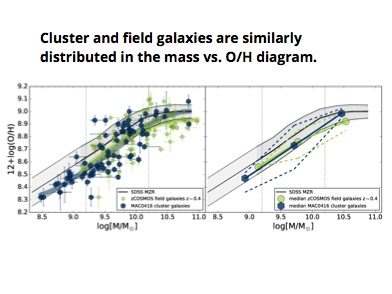
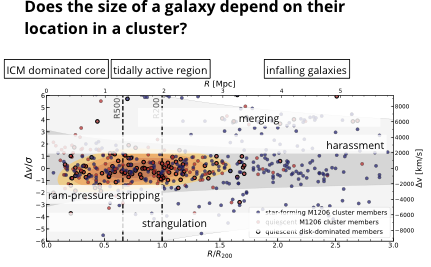
Current research on the co-evolution of galaxies and the cosmic web
“How do galaxies like our own Milky Way form and evolve in our universe?” is one of the biggest unsolved mysteries of modern science. Today it is clear that to answer this question requires us to understand the detailed physics at play within galaxies, the physics of the large-scale structure of the universe that galaxies inhabit (the cosmic web, characterised by voids, filaments, walls and nodes), and the cosmological model that describes the global content and scale of the universe as a whole. In particular, cosmic web filaments might contain half of the matter of the Universe, including around half of the warm gas.
The combined output of long-awaited instruments, including Euclid, WEAVE, 4MOST, JWST, LSST and SKA, will be essential to answer one of the key questions in astrophysics today: How do galaxies form and evolve in the large-scale distribution of matter in the universe?
My work directly responds to this question and probes the formation of structures on multiple scales: I lead investigations that integrate the main morphological properties of the cosmic web on large scales (Euclid) with deep zoom-in views of galaxy cluster outskirts that regulate galaxy transformation (WEAVE, 4MOST). This multi-scale approach is a key ingredient for our community to 1) measure the history of the universe and 2) unveil the processes that form and transform galaxies, including their bulges and disks.
My extensive published simulation-based work delivered firm theoretical predictions and a proven strategy to 1) map the structure of the cosmic web, with a focus around nodes and 2) measure galaxy properties including morphologies (Kuchner+2020; 2021; 2022; Bisigello, Kuchner+2020; Rost, Kuchner+2021, 2023; Cornwell, Kuchner+ 2022, 2023a, 2023b; Haggar, Kuchner+ 2022; Ferreira, Conselice, Kuchner+2022; Bretonnière, Kuchner+2023, Malavasi, Sarron, Kuchner+2024submitted). My role as connector at the forefront of both simulation (The ThreeHundred cluster modelling project) and observation (WEAVE, 4MOST, Euclid) teams is a fundamental aspect of my work.
To understand the formation and evolution of galaxies in the cosmic web, we must understand the flows of matter from voids to walls and filaments to galaxies, and galaxies into nodes
Left: snapshot of the ThreeHundred simulation showing matter accretion into galaxy clusters (Kuchner+2021) Middle: Analysis of the complex accretion histories of galaxies onto clusters (Kuchner+2022). Right: Observations across scales with upcoming instruments such as WEAVE and Euclid will bridge cosmic web science with galaxy formation and evolution theory. (Image shows the galaxy cluster MACSJ0717. Credit: NASA, ESA and the HST Frontier Fields team (STScI).)
Background
The matter distribution of the Universe follows a web-like structure, consisting of sheets, filaments, knots and voids. Throughout the history of the Universe, this cosmic web is providing the environment in which galaxies form and evolve. Our current theories acknowledge both extrinsic (e.g., environment} and intrinsic (e.g., galaxy stellar mass) physical mechanisms as important factors of this process. However, galactic masses are highly dependent on their large-scale surrounding.
The outskirts of galaxy clusters are the points of contact that link the cosmic web to the confined realms of cluster cores at its knots. They have emerged as one of the new frontiers to study the mass assembly in the Universe as well as galaxy evolution in the context of large-scale environment. While cluster cores are proved and tested critical sites for studying the influence of the environment on galaxy evolution, it is in their filamentary outskirts where we find the smoking guns for galaxy transformation: e.g., passive spirals, post starburst and jellyfish galaxies, whose stellar populations and morphologies indicate a recent change in star formation and/or dynamical history (Kuchner et al 2017).
In order to trace the impact of structure growth on the galaxy population, we must therefore consider galaxies in groups and filaments well beyond the virial radius. As a builder, I am significantly contributing to the survey readiness of the upcoming WEAVE Wide-Field Cluster Survey with the new instrument WEAVE on the William Herschel Telescope, starting in 2021. Over the next five years, we will quantify cluster outskirts and study the infalling galaxy population, which includes determining whether significant pre-processing accelerates the quenching of star formation.
To prepare for the survey and test ways of finding filaments feeding clusters, I have used hydrodynamical zoom-in simulations from the ThreeHundred project. Transforming the simulations into mock-observations also allows us to forecast the reliability of filament finding -- an important asset given the difficulties of identifying cosmic web structures in redshift space. Furthermore, understanding "filament galaxies" as a combination of group-, backsplash- and filament galaxies, that each affect star formation according to their unique environment, helps to reconstruct the different modes of pre-processing.
Related details can be found in a series of recently published papers:
Kuchner et al 2021 -- Cosmic filaments in galaxy clustre outskirts: quantifying finding filaments in redshift space
Kuchner et al 2020 -- Mapping and characterization of cosmic filaments in galaxy clusters outskirts: strategies and forecasts for observations from simulations
Rost, Kuchner et al 2021 -- The ThreeHundred: the structure and properties of cosmic filaments in the outskirts of galaxy clusters
Detailed investigation of Galaxy cluster outskirts: pre-processing with WEAVE and 4MOST
Wide investigation of Cosmic Web: co-evolution with Euclid and 4MOST
Approach:

